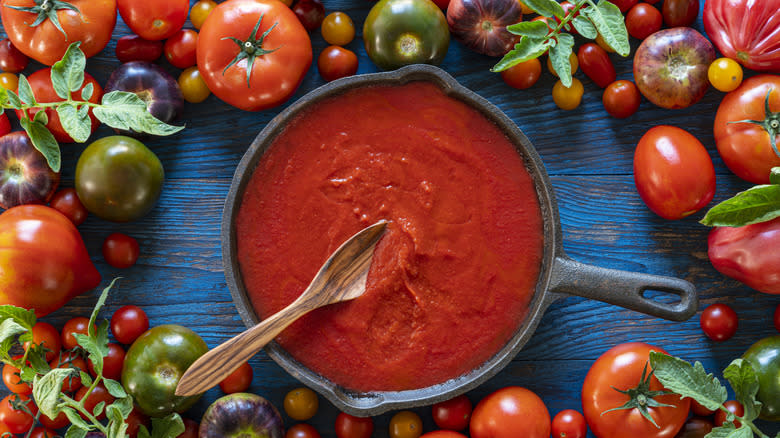How To Keep Your Garlic From Burning For The Best Tomato Sauce

Tomato sauce is one of those recipes that's easy to learn, but difficult to master. It's not hard to cook canned tomatoes with aromatics and wind up with something tasty, but in pursuit of the best results, you might make more sauce mistakes that you know. One ingredient that doesn't get a lot of attention -- but should -- is the garlic. Chopping it up and tossing it in the sauce is fine, right? That technically get the job done, but garlic is really a finicky beast, requiring the right amount of cooking to get the most flavor out of it and elevate your recipe.
Both raw and overcooked garlic have a tendency to overpower other ingredients, whether with a pungent and stinging bite or an acrid and burnt flavor. Striking the perfect middle ground comes down to quickly sautéing it, then adding liquid to the pan. The liquid component, whether it be broth, tomato puree, or even wine, will slow down the garlic's cooking process. You'll cut short its exposure to the kind of intense, direct heat that can cause it to easily overcook.
This technique will unlock the garlic's full flavor potential, preventing your sauce from taking on an unpleasantly raw flavor or a burnt one. Best of all, it works for both quick-cooking sauces (which might not cook the garlic enough by default) and simmer-all-day recipes.
Read more: 11 Of The Best Cooking Tips From Bobby Flay
Garlic Can Be Added To Pasta Sauce Earlier Than In Most Dishes

Many long-cooking recipes add garlic near the end of the cooking process, so it won't overcook, but tomato sauce works a little differently. Since the garlic will be cooked in liquid after the initial sauté, you can add it to the pot earlier than in a "dry" recipe. If you're really afraid of burnt garlic, you might be tempted to skip the pre-cooking step, but that quick frying job in the hot pan is a must-do.
If you just throw minced garlic into bubbling pasta sauce, it creates a more a raw garlic bite. This can be fine, if it suits your tastes, but it might not be the result your recipe is meant to create. Instead, you want to briefly cook the garlic in the pan, along with any meat and/or onions and other aromatics. The garlic's flavor will mellow and turn sweet yet robust, for a better final result. The meat and onions also benefit from some caramelization, making them much less bland than if they were boiled in the sauce only.
From there, deglaze the pan with liquid (using some tips to deglaze like a pro if you're a novice), add your other ingredients, then bring down the temperature and let the sauce simmer. This not only allows the sauce to thicken over time, but also extracts the most flavor out of your garlic -- without the risk of burning it.
Other Garlic Mistakes To Watch Out For

Beyond the realm of tomato sauce, there are all kinds of mistakes you can make with garlic. For example, if you mince it into small pieces for all your recipes, it's time to branch out and prep it in more suitable ways. Grating garlic with a microplane (or even a cheese grater) helps it smoothly blend into soups or distribute evenly in marinades and stir-fries. Conveniently, you can also leave the cloves whole and use them to flavor sauces or stews, then fish out the cloves at the end of the process.
As for storing garlic, putting it in the fridge is a surprising mistake. The cold temperature causes the garlic to sprout faster, so don't be afraid to leave it out on your counter or in the pantry, as it will last for six months -- plenty of time to use it up.
Using jarred, pre-cut garlic, meanwhile, has all sorts of negatives. The flavor tends to be bitter and metallic, and it's not as cost-efficient as just buying whole garlic and cutting it yourself. Store-bought brands may have even been treated with bleach or phosphoric acid, so if you're concerned about additives, whole garlic is the way to go.
Read the original article on Daily Meal.


